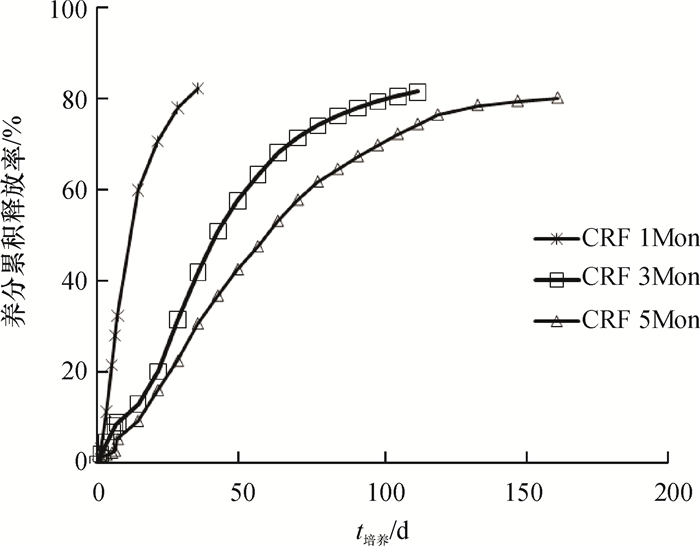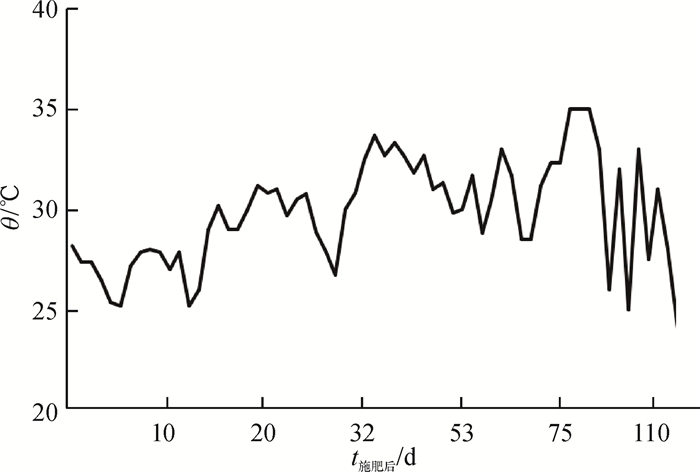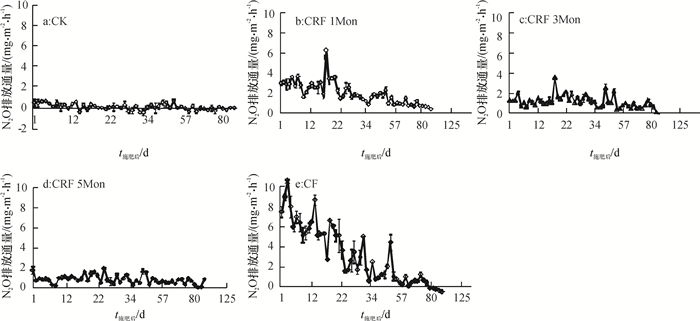Effects of longevity of controlled-release fertilizer on N2O emission reduction in bare soil and banana-planted soil
-
摘要:目的
研究不同肥效期的控释肥对裸地和栽培作物土壤N2O减排效果的影响,为进一步研究大田条件下的减排效果提供参考。
方法通过盆栽试验,采用静态箱法和气相色谱分析技术,对比研究了1、3、5个月3个肥效期的植物油包膜控释肥(CRF 1Mon、CRF 3Mon和CRF 5Mon)及其核心复合肥分别在裸地和栽培香蕉土壤中的N2O日排放通量和累积排放量。
结果控释肥肥效期显著影响N2O排放峰数量、最大排放峰通量、累积排放量及增温潜势。裸地时,CRF 1Mon、CRF 3Mon和CRF 5Mon排放峰数量分别为5、3和3个,出峰时间均为监测的中后期,最大排放峰通量为CRF 1Mon>CRF 3Mon>CRF 5Mon,CRF 3Mon和CRF 5Mon的累积排放量显著低于CRF 1Mon;栽培香蕉时,仅CRF 1Mon和CRF 3Mon在监测前期有明显的N2O排放峰,分别为1和3个,累积排放量为CRF 1Mon>CRF 3Mon>CRF 5Mon。施用肥效期长的控释肥对栽培香蕉土壤的N2O减排效果优于裸地,裸地时累积排放量降幅为24.06%~52.81%,栽培香蕉土壤的累积排放量降幅为54.22%~75.34%。
结论施用肥效期长的控释肥以及栽培作物是减少土壤N2O排放、降低温室效应的有效措施。
Abstract:ObjectiveTo study effects of longevity of controlled-release fertilizer (CRF) on mitigation of N2O emission from bare soil and banana-planted soil, and to provide references for further research on mitigation of N2O emission from the field.
MethodUsing static chamber-GC technique, pot experiment was conducted to study N2O fluxes and cumulative emission from bare soil and banana-planted soil fertilized with CRF of 1, 3 and 5 months longevity (marked as CRF 1Mon, CRF 3Mon and CRF 5Mon respectively).
ResultCRF longevity significantly affected the number of emission peaks, maximum emission peak flux, cumulative emissions and global warming potential of N2O from bare soil and banana-planted soil. There were 5, 3 and 3 N2O emission peaks of CRF 1Mon, CRF 3Mon and CRF 5Mon from bare soil in the middle and later stages. Maximum emission peak flux decreased in order of CRF 1Mon > CRF 3Mon > CRF 5Mon. The cumulative emissions of CRF 3Mon and CRF 5Mon were significantly lower than that of CRF 1Mon. There were 1 and 3 N2O emission peaks of CRF 1Mon and CRF 3Mon from banana-planted soil only in the early stage. N2O cumulative emissions decreased in order of CRF 1Mon > CRF 3Mon > CRF 5Mon. Prolonged CRF application was more effective on reducing N2O emission from banana-planted soil than that from bare soil. The cumulative emission decreased by 24.06% to 52.81% in bare soil, and decreased by 54.22% to 75.34% in banana-planted soil.
ConclusionProlonged CRF application and crop planting can help effectively reduce soil N2O emission and the greenhouse effect.
-
Keywords:
- controlled-release fertilizer /
- longevity /
- banana cultivation /
- N2O emission
-
-
表 1 控释肥肥效期对香蕉吸氮量及氮素利用率的影响1)
Table 1 Effect of controlled-release fertilizer longevity on banana nitrogen uptake and nitrogen use efficiency
处理 吸氮量/ (g·盆-1) 氮素利用率/% CRF 1Mon 1.43±0.06 a 63.82±3.08 a CRF 3Mon 1.37±0.12 a 60.76±6.39 a CRF 5Mon 1.24±0.04 b 54.15±2.07 b CF 1.42±0.08 a 63.30±3.92 a 1) 表中数据均为3次重复的平均值±标准误;同列数据后,凡是有一个相同字母者,表示肥料处理间差异不显著(Duncan’s法,P>0.05)。 表 2 控释肥肥效期对N2O平均排放通量的影响1)
Table 2 Effect of controlled-release fertilizer longevity on mean N2O flux
mg·m-2·h-1 处理 裸地 栽培香蕉土壤 平均值 CK 0.11±0.00c(b) 0.16±0.02e(a) 0.14d CRF 1Mon 1.92±0.07a(a) 1.18±0.03b(b) 1.55b CRF 3Mon 1.28±0.07b(a) 0.93±0.03c(b) 1.11c CRF 5Mon 1.29±0.02b(a) 0.71±0.01d(b) 1.00c CF 1.95±0.06a(b) 2.37±0.13a(a) 2.16a 平均值 1.31(a) 1.07(b) 1) 表中数据为3次重复的平均值±标准误;同列数据后,凡是有一个相同字母者表示不同肥料处理间差异不显著(Duncan’s法,P>0.05);同行数据后括号内,凡是有一个相同字母者表示栽培香蕉与裸地间差异不显著(Duncan’s法,P>0.05)。 表 3 控释肥肥效期对N2O累积排放量、增温潜势和排放系数的影响1)
Table 3 Effects of controlled-release fertilizer longevity on cumulative emission, global warming potential, and emission coefficient of N2O
处理 N2O累积排放量2)/(mg·盆-1) 增温潜势/(g·m-2) 排放系数/% 裸地 栽培香蕉土壤 平均值 裸地 栽培香蕉土壤 平均值 裸地 栽培香蕉土壤 平均值 CRF 1Mon 227.03±8.39a 77.77±1.93b 152.40b 2 290.85±79.66a 857.42±18.28b 1 574.14b 7.41±0.27a 2.40±0.06b 4.91b CRF 3Mon 146.58±9.04b 58.81±2.06c 102.70c 1 527.41±85.78b 677.52±19.54c 1 102.46c 4.78±0.29b 1.78±0.07c 3.28c CRF 5Mon 147.54±2.50b 41.88±0.42d 94.71c 1 536.44±23.72b 516.86±4.01d 1 026.65c 4.81±0.08b 1.23±0.01d 3.02c CF 231.53±7.40a 169.86±9.72a 200.69a 2 333.57±70.25a 1 731.43±92.23a 2 032.50a 7.56±0.24a 5.41±0.32a 6.49a 平均值 188.17(a) 87.08(b) 1 922.06(a) 945.81(b) 6.14(a) 2.70(b) 1) 表中数据为3次重复的平均值±标准误;同列数据后,凡是有一个相同字母者表示不同肥料处理间差异不显著(Duncan’s法,P>0.05);同行数据后括号内,凡是有一个相同字母者表示栽培香蕉土壤与裸地间差异不显著(Duncan’s法,P>0.05); 2) N2O累积排放量为施肥后增加的累积排放量,即扣除无肥对照的累积排放量。 -
[1] DENMAN K L, FAHEY D W, FORSTER P, et al. Contribution of working group I to the fourth assessment report of the intergovernmental panel on climate change [C]//SOLOMON S, QIN D, MANNING M, et al. Climate change 2007: The physical science basis. Cambridge: Cambridge University Press, 2007: 499-587.
[2] 张强, 巨晓棠, 张福锁.应用修正的IPCC2006方法对中国农田N2O排放量重新估算[J].中国生态农业学报, 2010, 18(1):7-13. http://kns.cnki.net/KCMS/detail/detail.aspx?filename=zgtn201001003&dbname=CJFD&dbcode=CJFQ [3] 陈冠雄, 商曙辉, 于克伟, 等.植物释放氧化亚氮的研究[J].应用生态学报, 1990, 1(1):94-96. http://cdmd.cnki.com.cn/Article/CDMD-10307-1013282633.htm [4] 李楠, 陈冠雄.植物释放N2O速率及施肥的影响[J].应用生态学报, 1993, 4(3):295-298. http://kns.cnki.net/KCMS/detail/detail.aspx?filename=yysb199303013&dbname=CJFD&dbcode=CJFQ [5] REGINA K, SYVA SALO E, HANNUKKALA A, et al. Fluxes of N2O from farmed peat soils in Finland[J]. Eur J Soil Sci, 2004: 55(3):591-599. doi: 10.1111/ejs.2004.55.issue-3
[6] 杨兰芳, 蔡祖聪.施氮和玉米生长对土壤氧化亚氮排放的影响[J].应用生态学报, 2005, 16(1):100-104. http://www.cnki.com.cn/Article/CJFDTOTAL-YYSB200501020.htm [7] 韩艳玉. 不同种类包膜肥料氮素溶出特性及对环境影响效应的研究[D]. 沈阳: 沈阳农业大学, 2011. http://cdmd.cnki.com.cn/Article/CDMD-10157-1012278373.htm [8] AKIYAMA H, YAN X, YAGI K. Evaluation of effectiveness of enhanced-efficiency fertilizers as mitigation options for N2O and NO emissions from agricultural soils: Meta-analysis[J]. Global Change Biol, 2010, 16(6): 1837-1846. http://europepmc.org/abstract/AGR/IND44366243
[9] SHOJI S, DELGADO J, MOSIER A, et al. Use of controlled release fertilizers and nitrification inhibitors to increase nitrogen use efficiency and to conserve air and water quality[J]. Commun Soil Sci Plant Anal, 2001, 32(7/8):1051-1070. doi: 10.1081/CSS-100104103?journalCode=lcss20
[10] 董红敏, 李玉娥, 陶秀萍, 等.中国农业源温室气体排放与减排技术对策[J].农业工程学报, 2008, 24(10): 269-273. doi: 10.3321/j.issn:1002-6819.2008.10.055 [11] 丁洪, 王跃思, 秦胜金, 等.控释肥对土壤氮素反硝化损失和N2O排放的影响[J].农业环境科学学报, 2010, 29(5):1015-1019. http://kns.cnki.net/KCMS/detail/detail.aspx?filename=nhbh201005035&dbname=CJFD&dbcode=CJFQ [12] 谷佳林, 边秀举, 徐凯, 等.不同缓控释氮肥对高羊茅草坪生长及氮素挥发的影响[J].草业学报, 2013, 22(2):235-242. doi: 10.11686/cyxb20130230 [13] JUMADI O, HALA Y, MUIS A, et al. Influences of chemical fertilizers and a nitrification inhibitor on greenhouse gas fluxes in a corn (Zea mays L.) field in Indonesia[J].Microb Environ, 2008, 23(1):29-34. doi: 10.1264/jsme2.23.29
[14] MALJANEN M, LIIKANEN A, SILVOLA J, et al. Nitrous oxide emissions from boreal organic soil under different land-use[J]. Soil Biol Biochem, 2003, 35(5): 689-700. doi: 10.1016/S0038-0717(03)00085-3
[15] 刘芳, 李天安, 樊小林.华南地区覆膜旱种稻田甲烷排放及其与土壤水分和温度的关系[J].农业工程学报, 2013, 29(2):110-116. http://www.cnki.com.cn/Article/CJFDTOTAL-NYGU201302017.htm [16] 李方敏, 樊小林, 刘芳, 等.控释肥料对稻田氧化亚氮排放的影响[J].应用生态学报, 2004, 15(11): 2170-2174. doi: 10.3321/j.issn:1001-9332.2004.11.037 [17] 张蛟蛟, 李永夫, 姜培坤, 等.施肥对板栗林地土壤N2O通量动态变化的影响[J].生态学报, 2013, 33(16):4939-4948. http://kns.cnki.net/KCMS/detail/detail.aspx?filename=stxb201316014&dbname=CJFD&dbcode=CJFQ [18] 张怡, 吕世华, 马静, 等.控释肥料对覆膜栽培稻田N2O排放的影响[J].应用生态学报, 2014, 25(3):769-775. http://kns.cnki.net/KCMS/detail/detail.aspx?filename=yysb201403021&dbname=CJFD&dbcode=CJFQ [19] MAAG M, VINTHER F P. Effect of temperature and water on gaseous emissions from soils treated with animal slurry[J].Soil Sci Soc Am J, 1999, 63(4): 858-865. doi: 10.2136/sssaj1999.634858x
[20] 蒋静艳, 黄耀, 宗良纲.水分管理与秸秆施用对稻田CH4和N2O排放的影响[J].中国环境科学, 2003, 23(5):552-556. http://kns.cnki.net/KCMS/detail/detail.aspx?filename=zghj200305031&dbname=CJFD&dbcode=CJFQ [21] 于萍萍, 张进忠, 林存刚.农田土壤N2O排放过程影响因素研究进展[J].环境与可持续发展, 2006(5):20-22. http://kns.cnki.net/KCMS/detail/detail.aspx?filename=hjkd200605007&dbname=CJFD&dbcode=CJFQ [22] 赵秀芬, 房增国, 李俊良.几种有机高聚物包膜肥料养分释放速率研究[J].中国农学通报, 2009, 25(19): 139-141. http://www.cnki.com.cn/Article/CJFDTOTAL-ZNTB200919032.htm [23] 杜建军, 王新爱, 廖宗文, 等.不同浸提条件对包膜控/缓释肥水中溶出率的影响[J].植物营养与肥料学报, 2005, 11(1):71-78. doi: 10.11674/zwyf.2005.0112




 下载:
下载:



